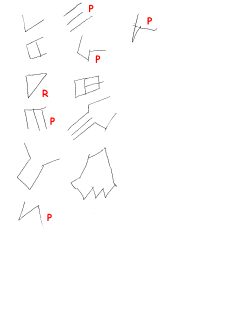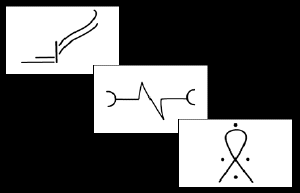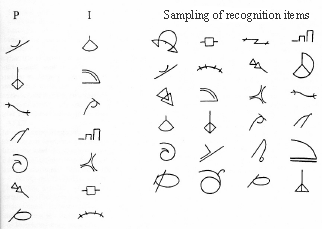
|
Development of Neuropsychological Tests |
|
| Design Fluency | |
|
In the 1970's Dr. Jonesgotman developed a test of right frontal-lobe function. Based on the material-specific specialization of the right (nondominant hemisphere) for nonverbal material and on the known reduced verbal fluency of patients with left frontal-lobe damage, the test requires production of novel (original) abstract designs under a time constraint. This nonverbal fluency test ("Design Fluency") proved sensitive to right frontal-lobe damage and is an important part of the standard cognitive test battery at the MNH and elsewhere. Jones-Gotman M, Milner B. Design Fluency: The invention of nonsense drawings after focal cortical lesions. Neuropsychologia , 15 (1), 653 - 674, 1977. Jones-Gotman M. Localization of lesions by psychological testing. Epilepsia , 32 (Suppl. 5), 41-52, 1991. Jones-Gotman M. and Djordjevic J. Neuropsychological testing in presurgical evaluation. In: The Treatment of Epilepsy 3rd Edition. S. Shorvon, E. Perucca and J. Engel (Eds.), Blackwell Science Ltd., Oxford. In press, 2008. |
|
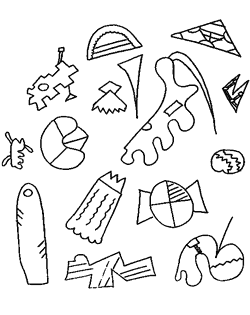 Example: healthy performance Novelty Score = 15 |
Example: right frontal performance |
|
|
|
|
|
|
|
A basic aspect of Dr. Jonesgotman's tasks is that they compare functions of the two hemispheres using highly similar paired tasks that differ only in one being verbal and the other nonverbal. The AWL and ADL are one example of paired tasks. Each task contains 13 items to be learned, either abstract words or abstract designs. The paradigm consists of four learning trials and a 24-hour delayed recall test. We find a retention deficit on the AWL in individuals with left temporal-lobe dysfunction and a learning deficit on the ADL in individuals with right temporal-lobe dysfunction. Three equivalent versions of these tasks (for retest) have been developed; the AWL is also equivalent in English and French. Recognition tests have been developed recently and are currently being validated. Jones-Gotman M. Right hippocampal excision impairs learning and recall of a list of abstract designs. Neuropsychologia, 24 (5), 659-670, 1986. |
|
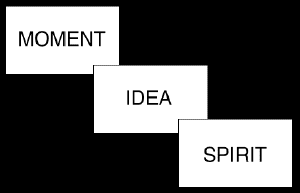 Example: abstract words from AWL |
Example: abstract designs from ADL |
|
|
|
|
Together with Viviane Sziklas and Agnieszka Majdan, Dr. Jonesgotman developed a nonverbal learning test designed to be an analog to the well-known Rey Auditory Verbal Learning Test (RAVLT). Like the RAVLT, the AFLT consists of five learning trials, an interference trial, 30-minute delayed recall, and delayed recognition.This pair of tasks also yields a left temporal retention deficit for words and a right temporal learning deficit for designs. There are three equivalent versions of each test, (and for words, English and French versions) to allow retest. Majdan A, Sziklas V, Jones-Gotman M. Performance of healthy subjects and patients with resection from the anterior temporal lobe on matched tests of verbal and visuoperceptual learning. Journal of Clinical and Experimental Neuropsychology, 18, 416-430, 1996. Sziklas V, Jones-Gotman M. French version of the Rey Auditory Verbal Learning Test and nonverbal analog: Equivalent forms and validation in a clinical sample. Canadian Journal of Neurological Sciences, 35(3), 323-330, 2008. |
|
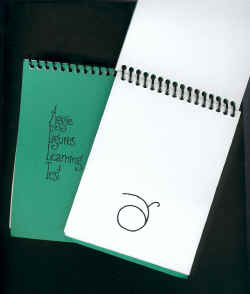 AFLT test booklets
|
|
Twins Test Jonesgotman and Lauren Dade developed a difficult face learning and memory test, the “Twins Test”, to assess the face recognition functions of the right hemisphere. This test consists of four learning trials, with serial yes-no recognition assessed after the first and fourth trial and again after a 24-hour delay. The unique feature of this task, which makes it a difficult one, is that the foils used for the recognition trials are altered versions of the target faces. The Twins Test is sensitive to right temporal-lobe dysfunction. Additional versions of the test are currently being developed, for retest. Dade LA, Jones-Gotman M. Face learning and memory: The Twins Test. Neuropsychology, 15(4), 525-534, 2001.
Example: faces from the Twins Test. Target face is in upper left corner; three foil faces are altered versions of target face.
|
Intracarotid Anesthetic Procedures (IAP) The IAP is a highly specialized test that originated at the Montreal Neurological Institute ( MNI ) in 1955, when Juhn Wada was a resident here. This test is used in selected patients who are candidates for elective brain surgery and for whom there is a question about the lateralization of language or about the potential efficiency of memory function following a planned surgical resection in a temporal lobe. The procedure consists of temporary inactivation of one cerebral hemisphere by injection of a barbiturate (usually sodium amobarbital) while speech and memory tests are administered to the awake hemisphere. At the MNI we have tested well over 1500 patients and, since both hemispheres are tested in most patients, have thus performed more than 3000 separate tests. In 1993 Jones-Gotman and colleagues redesigned the MNI IAP in five equivalent forms, and the new MNI procedure has been adopted by several other centers around the world. Following several prolonged shortages of amobarbital, our team switched to a new anaesthetic agent, etomidate, for performance of the IAP. At the same time we introduced an important change in the procedure, and named the new test the “etomidate speech and memory test”, or e SAM. In a “standard” IAP the full drug effect lasts only about three minutes after injection, after which it wanes and disappears. This necessitates speedy testing and results in some uninterpretable memory tests when items for later recognition are introduced after the drug is no longer active. The change introduced by the e SAM is that the level of hemianesthesia is maintained by infusion after the initial injection of etomidate, allowing all critical testing to take place while the drug remains fully active. The first article describing our use of etomidate and the new procedure was published in Neurology in December, 2005. In addition to the references below, several others about the IAP can be found in the selected publications listed in this website. Jones-Gotman M, Sziklas V, Djordjevic J. Intracarotid Amobarbital Procedure and Etomidate Speech and Memory Test. Canadian Journal of Neurological Sciences, in press, 2008. Jones-Gotman M, Smith Ml, Wieser HG. Intraarterial amobarbital procedures. In: Epilepsy: A Comprehensive Textbook: Second edition. J Engel Jr. and T Pedley, (Eds.), Lippincott Williams & Wilkins , New York , 1833-1841, 2008. Jones-Gotman M, Sziklas V, Djordjevic J, Dubeau F, Gotman J, Angle M, Tampieri D, Olivier A, Andermann F. Etomidate speech and memory test: A new drug and improved intracarotid procedure. Neurology, 65 (11), 1723-1729, 2005. |
|
Montreal Neurological Institute
McGill University
© 2005
